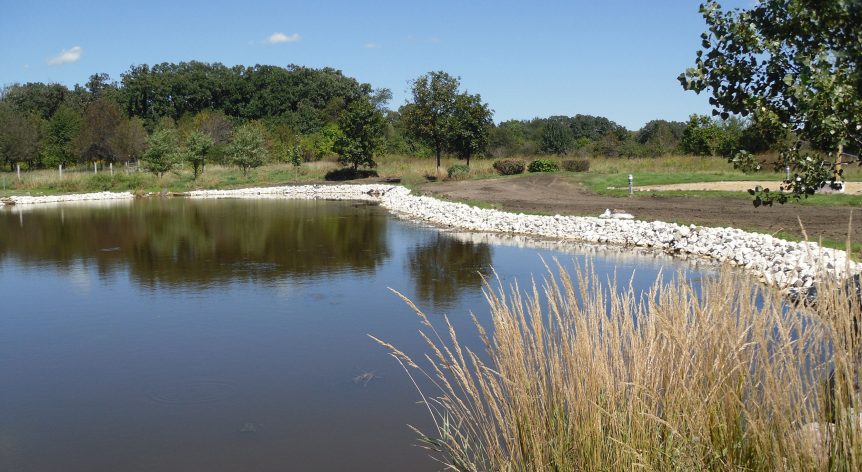Here’s Everything You Need to Know About Rip Rap Seawalls—From Start to Finish!
If you live or work near a body of water, one of the most common problems comes from the location itself. How do you stop water currents from wearing away at your shoreline keep the aesthetic appeal as you do so?
The answer is a rip rap retaining wall, also known as a rip rap seawall.
Seawalls protect your shore from harmful elements. They can be constructed out of a variety of materials, such as steel, aluminum, vinyl, and wood.
Rip rap seawalls differ from other types of seawalls because they consist primarily of loose rocks. However, as we will see, they are an excellent option for guarding your property and looking good while doing it.
This guide will take an in-depth look at how effective rip rap retaining walls can be!
Learn More about our Rip Rap Seawalls Service
What is a Rip Rap Retaining Wall?
A rip rap retaining wall is made from organic material, primarily rocks, to defend certain areas from damaging conditions. It is also referred to as rock armor, shot rock, or rubble. Professionals lay down the rocks in a way that prevents waves from causing erosion.
Erosion occurs when the motion of the water continuously strikes a certain area. This motion causes the property to break down and causes long-term harm. Erosion control ranks highly for most people choosing to invest in a seawall.
Rip rap provides a safe, environmentally friendly solution to the problem of erosion, which can be a major issue in certain areas such as these:
- Stream beds
- Shorelines
- Bridge abutments
- Pilings
- Shoreline structures
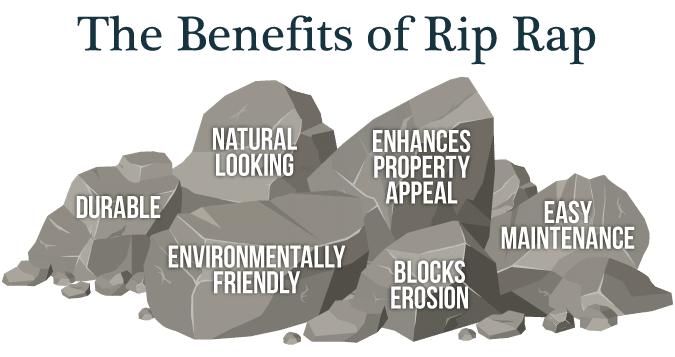
What is the Process for Rip Rap Installation?
Installing a rip rap seawall — or any seawall for that matter — is not a do-it-yourself project. You should instead consult a professional about how to install rip rap or any other seawall.
Here are a few of the factors you will need to consider when commissioning a rip rap seawall for your property.
Proper Measurements
Although incredibly effective against erosion, rip rap seawalls prove to be unstable when installed against a slope that is too steep. If the slope is too steep, then the rocks will be pushing against the force of gravity to retain their spot. Therefore, the measurements of the slope need to be accurate.
The slope of your shoreline should be at a 3:1 ratio when it comes to vertical and horizontal alignments. A 2:1 ratio is too steep to install a rip rap. That means your property may need to be excavated and leveled out in order to put down the rocks.
Compact Soil
During this excavation portion, workers will compact the soil. You want the soil to be as packed together as possible. This is generally done with machines such as backhoes. If the soil is too loose or not compact, then the risk of the rocks slipping around or water coming in increases.
And if you’re along a sandy shore, there is a compacting process for that as well. It may not involve machinery, but an effective method is physically stomping down the sand in order to compact it.
Attach Fabric
Before the rocks are placed on the shoreline, fabric must be attached. The filter fabric protects the soil from erosion if water gets under the rocks, providing you with an extra layer of protection.
The fabric needs to be attached securely so that the rocks don’t slip or move. One common method of attaching the fabric is to use 6” steel staples and staple the fabric to the shoreline.
As the fabric protects the soil, it uses the weight of the rocks to hold everything together. An improperly secured filter fabric can lead to issues you are trying to avoid, such as erosion.
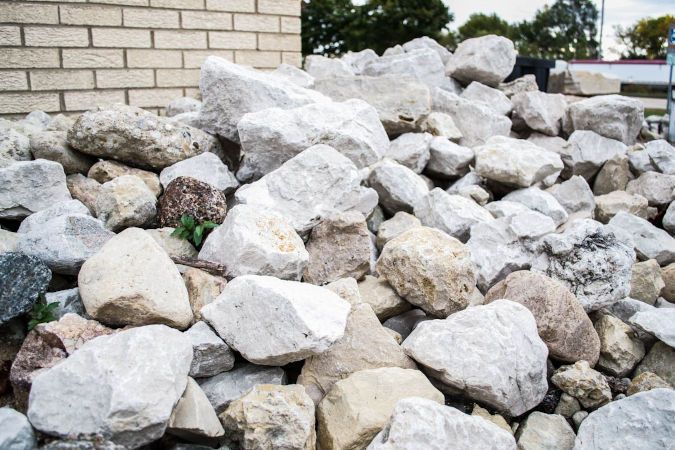
Put Down Rocks
Finally, when the rocks go down on the shoreline, they have to be properly sized. The size of the rocks depends on how big of a property they are going on.
Typically, small rip rap rocks of about 3” to 6” diameter are used most often on small ponds or no-wake areas on larger lakes. On these types of properties, the motion of the water frequency and constituency provides less opportunity for erosion, so smaller rocks get the job done.
However, if your property rests along a river shoreline or an inland lake shoreline, look for larger rip rap, typically 6” to 12” in diameter.
Those who use rip rap seawalls usually use granite or modular concrete blocks for their rip rap rocks. In some cases, building and paving demolition rubble works as well!
Again, this is not really a DIY project, but if you are attempting it, keep in mind one thing about the rock sizes. Improperly sized rocks increase the chance of damage or erosion. So, when in doubt, go with larger rocks.
Why Choose a Rip Rap Design?
Time and time again, people turn to rip rap as their go-to design for seawalls. Why? It is an environmentally friendly choice with easy maintenance and a lifespan that makes the cost well worth it.
Because of its advantages, many people use rip rap designs on their properties. You’ve probably seen the placement of stones along banks and shores before and never thought twice about it. That’s the point. It doesn’t stick out, and it doesn’t cause an eyesore.
Along with that advantage, rip rap gives plenty of others as well, such as these:
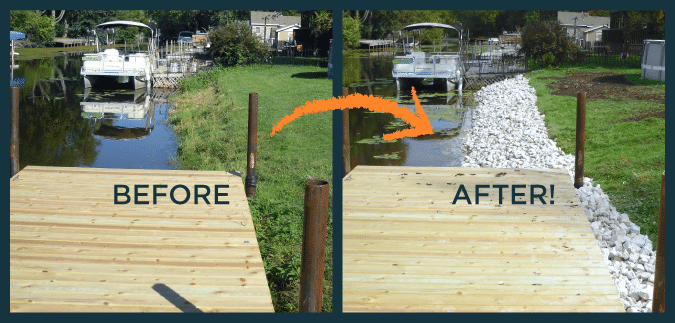
Erosion Control
We’ve spoken about the need for rip rap in terms of erosion control earlier, and it is one of the essential advantages of rip rap. Most seawalls protect against erosion, which is when the motion and current of water slowly strip away at your property and environment, but none do it as well as rip rap.
Because the rocks are placed along the shoreline, they become the first defense against the current. Erosion can happen from a variety of sources, including:
- Watercraft wake
- High winds
- Stormy weather
- Ice and shifting temperatures
- Runoff
- Loss of vegetation and trees
Rip rap acts as an energy dissipator, which means the energy from the waves is absorbed by the rocks. Some erosion control methods simply deflect the waves. But with rip rap, the energy is not sent somewhere else. That wave energy, which could cause harm elsewhere along your property, goes away when the waves hit the rocks.
Eco-Friendliness
Because rip rap is a natural element, it introduces and creates new habitats for animals and vegetation. Plants and vegetation can grow between the rocks and give it a more natural look as well.
When waves hit a high point, they cover the rip rap in water. During this time, it is a good spot for small sea creatures to seek shelter. Normally, the rocks chosen go well with the environment and compliment the area as well.
Enhancement of Property
Unlike steel or aluminum or wood or vinyl seawalls, rip rap blends into the environment around it. It becomes part of it. The organic material meshes with the surrounding area.
When it comes time to assess your property values, it will play a big role. Your property will be measured based on its overall appearance, and the natural look from rip rap adds to it.
Rip rap acts as a natural barrier between your property and the water. Even though it is protecting the shoreline, it also protects your home as well. Water leaks and flooding can occur when there is no barrier, and that can begin to get inside your home and do some real damage. This barrier gives your home a better sense of security, as well.
Easier to Maintain
The natural appeal and design of rip rap also offer an easier way to preserve the seawall. Where steel can rust, wood can rot, and vinyl can warp and deform, rip rap only needs maintenance in certain areas.
After a heavy storm or sudden change in hazardous weather conditions, such as snow and ice storms, you need to check on your rip rap seawall. More times than not, a few of the rocks will be damaged. If they are, you simply need to replace them to maintain the integrity of the seawall.
Furthermore, because the rocks are broken up and in pieces, it makes replacing them that much easier. If steel rusts, it means a bigger section will have to be replaced through cutting and welding. Wood rot can lead to termites infesting the entire seawall. But with rip rap, a quick change of one or two rocks a year will keep your property safe!
Even though we are in the Midwest, if there is ever a year without a major weather incident, you still need to check on your seawall annually to keep it in ship-shape!
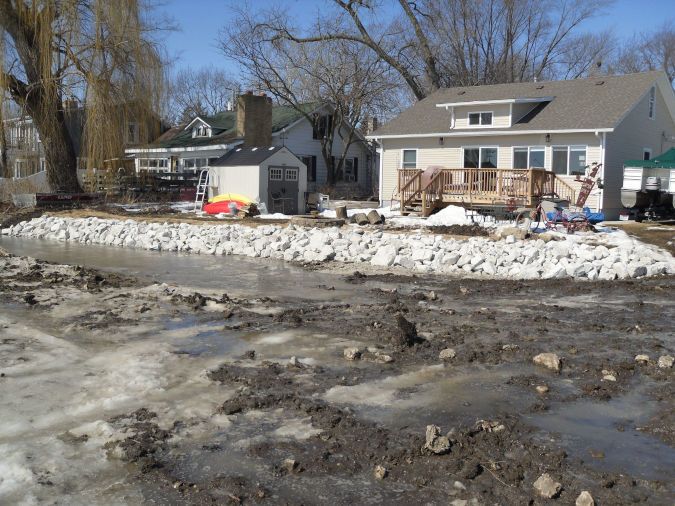
What Does Rip Rap Construction Cost?
While the cost of the installation depends on the individual project, having a rip rap seawall will save you money in the long run. Because the maintenance is easier on rip rap than other seawalls, the upkeep costs less as well.
Rip rap can be made from many different materials, as stated above. That means when one of the rocks becomes dislodged, or starts to wear down, the cost of removal and replacing it less than wood or vinyl. In those cases, the damage could be widespread, such as termites and rot, causing you to replace bigger sections.
Checking on the rip rap after every major weather incident and, at the very least, annually will give your seawall an incredibly long life expectancy.
Rip Rap Seawalls Give Great Protection and Property Appeal
If you are looking for a sturdy, reliable way to protect your property and increase its value, look no further than a rip rap seawall.
Living on a body of water such as a lake, river, or pond has immense benefits. Don’t let the disadvantages such as weather and erosion keep you from enjoying your property to its fullest potential. Rip rap provides a natural, eco-friendly, time-saving solution to protect your home.
It’s not a DIY project, but the professionals at Seawalls Unlimited are ready to jump in and give you a hand! Proper installation is of the utmost importance for projects like this, and you want your seawall put in by somebody you can trust. We’ll support you in every step of the way to guarantee the best possible protection!

